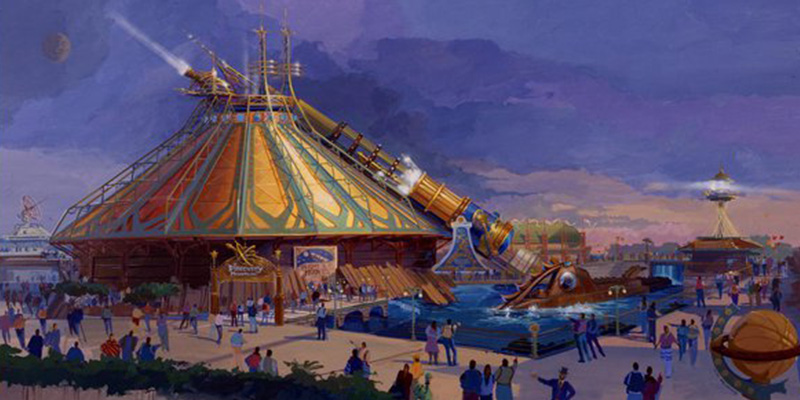It started out as more than just a ride. In the early 1990s, Disneyland Paris (then called “Euro Disney”) had planned a whole Jules Verne area, “Discoveryland,” to be one of the main features of the new amusement park.
According to researcher and documentarian Kevin Perjurer, the area’s centerpiece was going to be a giant copper and steel pavilion, and inside it would be a replica of The Mysterious Island, the home port of Captain Nemo from Verne’s 1872 novel, Twenty Thousand Leagues Under the Sea. Docked in a giant pool would be Nemo’s golden submarine, the Nautilus, which was to be its own walk-through attraction and feature an underwater restaurant. There was going to be a giant free-fall ride, paying homage to Verne’s 1864 novel, A Journey to the Centre of the Earth, and an ornate, Paris-Expo-esque matching train station to service the park’s perimetric railroad system. And there was to be a giant Space Mountain-inspired roller-coaster, designed after Verne’s 1865 novel From the Earth to the Moon: A Direct Route in 97 Hours, 20 Minutes.
Verne’s novel told the story of a group of scientists who gathered at the Baltimore Gun Club to began designing and constructing a giant gun that could shoot explorers to the moon. His novel was massively influential, and even inspired the French filmmaker and illusionist Georges Méliès, who shot explorers out of a canon into space, in his 1902 film A Trip to the Moon.
But the area, as it was planned, was never built. EuroDisney, which opened in 1992, faced terrible financial troubles that halted the Jules Verne project. Eventually, construction was green-lit, but only for the creation of the From the Earth to the Moon-themed roller-coaster, which was to be a cousin of DisneyLand and Disney World’s dark, indoor coaster Space Mountain.
Even with the design retraction and financial constraints, lead imagineer Tim Delaney oversaw the building of a masterpiece. Inside, and out, the ride was a sight to behold. The aesthetic of the whole area was beaux-arts steampunk, both ornate and mechanical: the exterior was shiny copper and steel, with glistening gears.
Along the side of the pavilion, there was a giant golden canon, which would shoot the guests “into space” to start the ride. The cars would slingshot forwards and upwards before ducking into the pavilion, zooming around (and upside-down) through space and eventually towards a smiling moon, before hurtling back to earth. It had a full narrative, and its own original score. The coaster was named “Space Mountain: From the Earth to the Moon.” And, for a time, it alone solved the financial problems suffered by EuroDisney (then called “Disneyland Paris”).
Perjurer explains the entire story of the coaster’s conception, manufacture, and legacy in an incredible episode of his fantastic investigative YouTube series, Defunctland, which explores the history of shuttered, failed, and forgotten amusement parks and attractions around the world.
The sad thing is, Perjurer uncovers, the Verne-inspired coaster only lasted a decade, from 1994 to 2004. The ride was dismantled somewhat and fully rebranded twice, after that, and although the pavilion’s bones remain intact, the ride inside barely resembles its former glorious state.
Watch the whole exposé below. (You absolutely should.)
